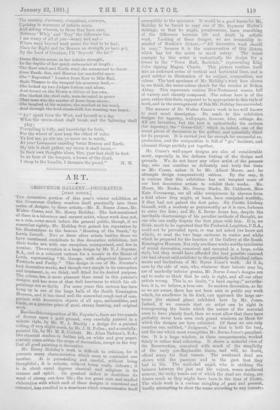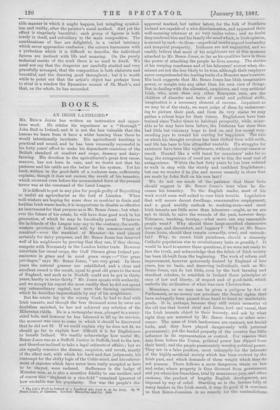ART.
G ROSVENOR GALLERY.—DECORATION.
[FIRST NOTICE.]
"Tau decorative portion of this year's winter exhibition at the Grosvenor Gallery resolves itself practically into three series of designs, by three artists,—Mr. E. Burne Jones, Mr. Walter Crane, and Mr. Henry Holiday. The last-mentioned of these is a laborious and earnest artist, whose work does not, as a rule, come much before the general public, though, if we remember rightly, Mr. Holiday first gained his reputation by his illustrations to the famous "Hunting of the Snark," by Lewis Carroll. Two or three other artists besides those we have mentioned contribute to this decorative exhibition, but their works are, with one exception, unimportant, and few in number. The exception is a large design by Mr. E. J. Poynter, RA., and is a coloured cartoon for a mosaic in time House of Lords, representing " St. George, with allegorical figures of Fortitude and Purity." This design is one of Mr. Poynter's best decorative works, and though very simple in its conception and treatment, is, we think, well fitted for its desired purpose. The colour, too, is more pleasant than usual in this painter's designs, and has none of that dull heaviness to which his oil- paintings are so liable. For some years this cartoon has been hung up in one of the large halls of the South Kensington Museum, and it has stood well the somewhat rough test of com- parison with decorative objects of all ages, nationalities, and kinds, as a genuine piece of good, strong drawing, and original work.
Besides this composition of Mr. Poynter's, there arc two panels of flowers upon a gold ground, very carefully painted in a minute style, by Mr. W. J. Muckly ; a design for a painted ceiling, of very slight merit, by Mr. J. H. Pollen ; and a carefully- painted lily, by Mr. M. R. Corbett. Mr. Alma Tadema's, R.A., two classical studies in Indian ink, on white and grey paper, scarcely come within the scope of decoration, except in the way that all good painting is decorative.
Mr. Henry Holiday's work is difficult to criticise, for it presents many characteristics which seem to contradict one another. It is painstaking and careful, without being thoughtful ; it is minute, without being really delicate ; it is in about equal degrees classical and religious in its manner and spirit. Its greatest defect is doubtless its -want of strong out-door life ; the too great care and studied elaboration with which each of these designs is conceived and executed, has .resulted in a weariness which communicates itself perceptibly to the spectator. It would be a good lesson for Mr. Holiday to be forced to copy one of Mr. Seymour Haden's etchings, so that he might, peradventure, learn something of the difference between life and death in artistic work. Looking at these designs, we are irresistibly re- minded of Ruskin's dictum,—" All decorative work should be easy," because it is the contravention of this dictum which has led the artist so much astray. The worst example by this artist is undoubtedly the design for a fresco in the " Town Hall, Rochdale," representing King John signing Magna Charta. This picture resolves itself into an awkward series of vertical and horizontal lines, and is good neither in illustration of its subject, composition, nor colour. The best specimen of Mr. Holiday's work here shown is, we think, the water-colour sketch for the reredos at Bolton Abbey. This represents various New-Testament scenes, full of variety and cleverly composed. The colour hero is of the pure, rather thin tints, supposed to be appropriate to this style of work, and in the management of this Mr. Holiday has succeeded.
The manner of Mr. Walter Crane's work is too well known to need much description. lie sends to this exhibition designs for tapestry, wall-paper, frescoes, tiles, ceilings, &c. All are inventive, but the best is undoubtedly the cartoon (for tapestry), the " Goose-Girl," which is, indeed, one of the truest pieces of decoration in the gallery, and splendidly fitted for its purpose. It is carried just far enough for successful re- production, and the composition is full of " go," incident, and pleasant things prettily put together.
Mr. Crane's wall-paper designs are also of considerable merit, especially in the delicate tinting of the design and grounds. We do not know any other artist of the present day, who can combine so delicately and truly flat tints as Mr. Crane, unless it be Mr. Albert Moore, and he attempts design comparatively seldom. By the way, it is curious that this exhibition has not tempted some of our best decorative artists to exhibit their works. Mr. Moore, Mr. Rooke, Mr. Stacey Marks, Mr. Caldecott, Miss Kate Greeuaway, are all alike conspicuous by absence from. a field where they might, at least, have competed worthily, if they had not gained the first prize. Sir Coats Lindsay himself, with a modesty as praiseworthy as it is rare, forbears to enter the lists ; and Mr. E. Burne Jones has, despite the inevitable shortcomings of his peculiar methods of thought, no one who can really dispute the first place with him. It is, we think, much to be regretted that Sir Frederick Leighton, P.R.A., could not be 'prevailed upon, or was not asked (we know not which), to send the two large cartoons in umber and white which he prepared for the lunettes of the Gallery at the South Kensington Museum. Not only are those works worthy specimens of mural decoration, conceived and executed in a largo, noble style, but they would have afforded the best possible contrast (we had almost said antidote) to the peculiarly individual refine- ments and limitations of Mr. Borne Joues's work. As it is, seen by the side of men, who, whatever their talents may be, are of markedly inferior genius, Mr. Burne Jones's designs are apt to make us think that he only is right, and all our other artists wrong. This is, no doubt, "a hard saying ;" neverthe- less, it is, we believe, a true one. In modern decoration, as far as we are aware, there has not been seen in public any work which, for excellence in its kind, can approach the large car- toons (for stained glass) exhibited here by Mr. Jones. Indeed, if we concede that an artist can be right in transgressing the limits which the nature of the material seem to have plainly fixed, then we must allow that there have probably never been seen such grand windows as those for which the designs are here exhibited. Of these we can only mention one, entitled, " Judgment," as that is both the best, and the one which most exemplifies Mr. Burne Jones's peculiari- ties. It is a large window, in three compartments, worked thinly in rather dead colouring. It shows a material view of the Resurrection, conceived with much of the simplicity of the early pre-Raphaelite times, and will, no doubt, offend many for that reason. The awakened dead are shown with the passions and in the garb that they had in life. The mail-clad angel, who is striking the balance between the just and the unjust, wears medifaval armour, the rocky tombs out of which the dead are rising, are drawn much as they might have been in the time of Giotto. The whole work is a curious mingling ,of past and present, hardly attempting to show the scene according to any conceiv- able manner in which it might happen, but mingling symbol- ism and reality, after the painter's usual method. And yet the effect is singularly beautiful ; each group of figures is both lovely in itself, and subsidiary to the main composition. The combinations of line are delightful, in a varied intricacy which never approaches confusion ; the colours harmonise with a perfection which it is difficult to describe, the individual figures are instinct with life and meaning. On the purely technical merits of the work there is no need to dwell. We need not say that the draperies are carefully studied and very gracefully arranged, that the composition is both elaborate and beautiful, and the drawing good throughout ; but it is worth while to point out that the artist's object has perhaps been to rival in a window the Byzantine mosaic of St. Mark's, and that, on the whole, he has succeeded.



































 Previous page
Previous page